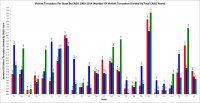rdale
EF5
2016 is forecast to be below normal in tornado alley... http://www.climatecentral.org/news/el-nino-tornado-season-19910
A common theme: a lot of good chase setups in the Plains, even with generally pedestrian annual CONUS tornado counts. The climatecentral forecast for below average activity in "Tornado Alley," if they mean "Texas to Nebraska" as they define it in the article, does not seem well-founded solely on the basis of ENSO. If anything, it's areas farther north and east which are less likely to see active tornado seasons during Nino, on average.

Now that is an awesome reference. Thanks for sharing! That graph is largely in line with the ENSO-related findings of my "chase season scoring system" (which emphasizes the number of tornado days first, and the number of tornadoes second):Going back to the 90s, 1992, 1995 (especially) and 1998 all had their fair share of setups that would probably be teaming with chasers now. It's not until you go back into the 80s where you start seeing some really ugly Nino springs showing up (of course not saying that won't happen). I mentioned before that the Northern Plains have been seeing at least one really red letter event in many of the recent mod/strong Nino decays.
I made this graph awhile back based on UCAR ENSO data of the number of violent (via Grazulis and a couple other sources) tornadoes per state in springs following winters of specific ENSO phase (green being neutral, red being El Nino and blue being La Nina) from 1900 through 2014. Has been normalized by dividing the totals by the number of the given ENSO years since neutral is more common than the other two.
Long story short, it seems the Plain states are just as likely, if not more, to get violent tornadoes in +ENSO or neutral years as -ENSO. Could probably broaden this to include EF/F2 or above, but I don't have Grazulis' book with me to work on that.
Now that is an awesome reference. Thanks for sharing! That graph is largely in line with the ENSO-related findings of my "chase season scoring system" (which emphasizes the number of tornado days first, and the number of tornadoes second):
ENSO has virtually no effect on southern Plains chase seasons
La Nina is somewhat preferred for northern Plains chase seasons
The regional discrepancies in your graph are particularly striking, though. It strongly supports the idea that La Nina really is preferred in a lot of the more eastern sections of the tornado-prone CONUS, explaining why it is often associated with higher annual tornado counts (since it doesn't really "hurt" most sections of the Plains either). But if you focus on the southern and central Plains alone, El Nino might actually be preferable. Obviously EF4-5s only is a limited sample size, but the signal for La Nina being a much bigger deal east of the Plains is unmistakable in your graph. (Caveat: 1974 and 2011 probably have a rather overwhelming effect for states like AL and TN -- but then again, they count!)
List of spring severe weather seasons during waning El Nino events since 2000:
2003
2005
2007
2010
2015
Would any Plains chaser really object to next spring representing some combination of the above? I mean, 2005 and 2015 weren't necessarily seasons everyone can agree on being wonderful, but even they weren't "bad." The others were pretty much undeniably good.
A common theme: a lot of good chase setups in the Plains, even with generally pedestrian annual CONUS tornado counts. The climatecentral forecast for below average activity in "Tornado Alley," if they mean "Texas to Nebraska" as they define it in the article, does not seem well-founded solely on the basis of ENSO. If anything, it's areas farther north and east which are less likely to see active tornado seasons during Nino, on average.
I probably sound like a broken record on this topic, but chasers who focus on the "traditional" Alley from TX to SD should not be worried about El Nino equating to a bad season -- particularly one that is waning as we head into spring.
That makes two of us @chrisbray but I never count out IL/IN during the spring - those damn warm fronts...Thanks for the sweet graphics Andy. Looks like I will likely have to make long hauls out of Illinois to OK/KS/NE for some good setups this year!
